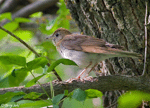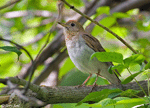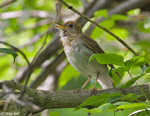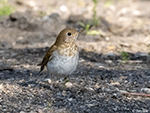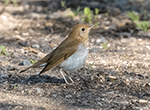| Length: 7 to 7.5 inches | Wingspan: 11 inches | Seasonality: Migrant / Summer |
| ID Keys: Tawny brown upperparts, white underparts with pale spotting on breast, plain face, black upper mandible and pinkish lower mandible with a black tip. | ||
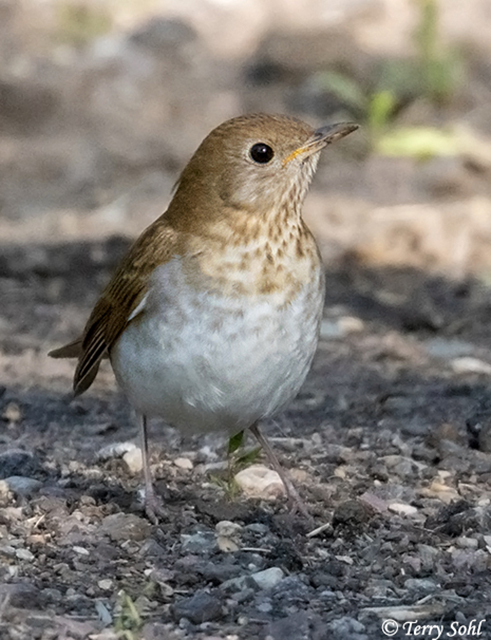 The Veery is a temporary
summer resident of forests of the northern U.S. and southern Canada, migrating
northward relatively late in spring and leaving in late summer. They are
most commonly seen hopping along the forest floor as they search for insects and
other prey items. It's beautiful song is a common summer sound in much of
the northern U.S., especially near sunset.
The Veery is a temporary
summer resident of forests of the northern U.S. and southern Canada, migrating
northward relatively late in spring and leaving in late summer. They are
most commonly seen hopping along the forest floor as they search for insects and
other prey items. It's beautiful song is a common summer sound in much of
the northern U.S., especially near sunset.
In South Dakota, Veeries are primarily rare migrants. However, small numbers do nest in the Black Hills (particularly in and around Spearfish Canyon), and in the far northeastern corner of the state.
Habitat:
During the summer breeding season, they are found in thickets and dense forest understories, often near water. They usually avoid areas without a significant understory. They are found in similar environments during migration and in winter in the tropics.
Diet:
The summer diet is mostly insects and spiders, as well as centipedes, snails, and small amphibians. During the winter months, they also consume great amounts of fruits and berries.
Behavior:
Forages low in the vegetation or along the ground. They will sometimes poke at decaying logs and flip over leaves at stones in search of insects. They also can hover while picking insects from foliage, and will occasionally fly out from a perch to snag a flying insect in mid-air.
Nesting:
June and July. Veery nest on the ground, or in vegetation low to the ground. Nests on the ground are placed in a protected area, such as against the base of a shrub, clump of herbaceous vegetation, a fallen log, or rock. Nests in vegetation are placed low to the ground in a dense shrub or small tree. The nest is a cup, built with a base of leaves, bark, and other vegetative material, and lined with fine roots, grasses, and/or hair. The female lays between 2 and 5 eggs, and she alone incubates them. Incubation lasts 12 to 14 days, and the young fledge from the nest after another 12 to 14 days.
Song:
Veeries have a pleasant descending whistling, veeyurr, veeyurr, veer, veer. They also have simpler calls that could consist of similar veer notes, or various whistles and chatters.
- Click here to hear a simple descending veer call of a Veery1
- Click here to hear the song of a Veery2
- Click here to hear another call of a Veery3
Migration:
Summers throughout much of the northern United States and southern Canada, as well as at higher elevations in the central Rockies and the Appalachians. Winters in the tropics.
Interactive eBird Map:
Click here to access an interactive eBird map of Veery sightings
Similar Species:
Veery have a general size, structure, and plumage that's similar to several other thrush species that either migrate through the state, or are found here as breeding birds in the summer months.
- Wood Thrush - Wood Thrush are migrants in the eastern part of South Dakota, and summer breeding residents in the southeast. They have warm rusty upperparts like a Veery, but have heavy black spotting on the breast, compared to less and lighter spotting on a Veery.
- Hermit Thrush - Hermit Thrush are migrants through South Dakota. They have warm rusty coloring on their rump and tail, but have grayish brown upperparts elsewhere. That compares to a more consistently warm rusty coloring on the upperparts of a Veery. Hermit Thrush also have more consistent and contrasty spotting on their breast, while Veery have less and lighter spotting.
- Swainson's Thrush - Swainson's Thrush are common migrants in the state. They are a grayish brown on their upperparts, compared to the warmer, rusty brown on a Veery. They also have an obvious, buffy-colored eye-ring, and more obvious spotting on the breast than a Veery
- Gray-cheeked Thrush - Gray-cheeked Thrush are very similar to Swainson's Thrush, but are a less common migrant. They too are grayish brown overall compared to the warmer brown of a Veery.
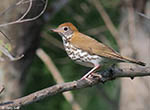 |
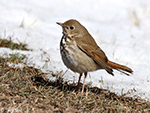 |
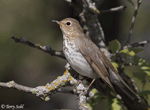 |
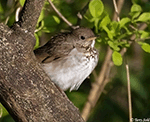 |
| Wood Thrush | Hermit Thrush | Swainson's Thrush | Gray-cheeked Thrush |
South Dakota "Hotspot":
Veeries are common summer breeders in Spearfish Canyon in the Black Hills. They can usually be found around Roughlock Falls in the Canyon, with very active singing and movement early in the morning and late in the evening in the spring and early summer months.
Conservation Status:
There are indications that populations may be in decline in recent decades. Increased access to nests for Brown-headed Cowbirds has increased parasitism, due to forest fragmentation and more edge habitat favorable for Cowbirds. However, they are still found across a broad geographic area and are common in parts of their range. The IUCN considers the Veery to be a species of "Least Concern"
Further Information:
Photo Information:
July 8th, 2008 - Near Roughlock Falls in Spearfish Canyon - Terry Sohl
Additional Photos:
Click on the image chips or text links below for additional, higher-resolution Veery photos.
Audio File Credits:
- 1Scott Gravette. Recorded in Mitchell County, North Carolina on June 10th, 2018. Original recording and information available from xeno-canto.
- 2Martin St-Michel. Recorded in Quebec on May 27th, 2017. Original recording and information available from xeno-canto.
- 3Mike Nelson. Recorded in Nantahala National Forest in North Carolina on May 29th, 2011. Original recording and information available from xeno-canto.
| Click on the map below for a higher-resolution view |
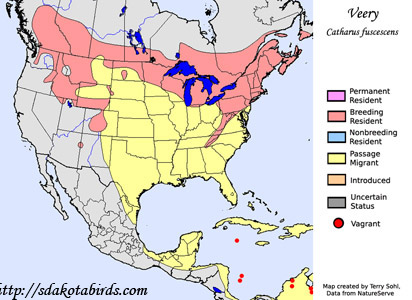 |
| South Dakota Status: Veeries are rare migrants throughout most of the state. However, they are locally common in the extreme northeastern part of the state, and in Spearfish Canyon in the Black Hills. They are rare summer residents elsewhere in the Black Hills. |
Additional Veery Photos
